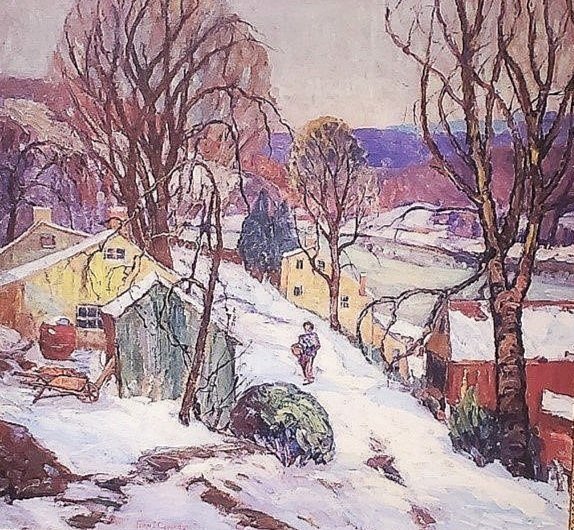Our History
Kalmia’s Story | Past Presidents | Articles | “Village Road” Painting | Photo Album
Established at a Key Point in U.S. Women’s History
In post-Civil War era America, as the women’s suffrage movement was gaining momentum, a variety of women’s clubs began forming in towns across the country. Women’s clubs provided opportunities for educational and cultural enrichment, and served as a “safe haven” for women to develop as social reformers in their communities. The coming together of women for a common cause was becoming an unstoppable force.
In 1892, during this time of growing social reform, a group of 45 women, educated and established, came together in the small river town of Lambertville, New Jersey, with a shared interest in reading and intellectual pursuits. They called themselves "The Reading Circle" and gathered several times a month in one another’s homes to discuss literature, art, gardening, music and drama. Their interests eventually expanded to include topics such as public health, industrial and social conditions, history, and current events. To be asked to join was an honor and women dressed for meetings in hats and gloves. In 1893, they moved their gatherings to the Quaker Meeting House at 39 York Street. The tradition of Monday meetings was established and continues to this day.
A year after organizing, The Reading Circle changed its name to “The Kalmia Club,” after the mountain laurel, Kalmia latifolia, which according to Club lore, grew in each of the 43 states in the Union. Its founders envisioned the Club's expansion throughout the country.
Federation
On May 20, 1897, the Kalmia Club became federated as a member of the New Jersey State Federation of Women’s Clubs (est. 1894), which provides opportunities for education, leadership training, and community service through participation in local clubs, enabling members to make a difference in the lives of others, one project at a time. (See certificate of federation below.)
Through the state federation, the Kalmia Club attained membership in the General Federation of Women's Clubs (est. 1890), an international women's organization dedicated to community improvement by enhancing the lives of others through volunteer service.
Clubhouse
On February 1, 1910, the clubhouse was "given and bequeathed" to The Kalmia Club by the Society of Friends, or Quakers. (See the transfer of ownership document in the Photo Album section below.) The Society had used the building as a meeting house for almost 20 years but now moved across the river due to dwindling membership. The Kalmia Club has met there ever since, except during World War II, when the clubhouse was used by the Red Cross as a surgical dressing station. The club marked this gift with a 100th anniversary celebration in 2010.
Incorporation
On October 1, 1968, the club became incorporated in the state of New Jersey as “Kalmia Club Inc.” and now has 501(c)(3) nonprofit status. Formal bylaws were written by which the club is governed under the stewardship of Board Officers and Trustees. A variety of committees, abuzz with activity, bring the club to life.
Recognition
In April 2012, the Kalmia Club was nominated to the National Register, as part of the Clubhouses of NJ Women’s Clubs. The club was recognized in the categories of: Education, Entertainment, and Social History. These were areas significant in women’s history in the later 19th century to early 20th century. This nomination also recognized the Kalmia clubhouse as the first building belonging to a local women’s club in New Jersey.
In 2022, Kalmia Club celebrated its 125th anniversary as a member of both the General Federation and NJ State Federation of Women’s Clubs. Additionally, the clubhouse was marked with a plaque from the U.S. Department of the Interior recognizing its historical designation in the State and National Register of Historical Places.
In 2024, the Kalmia Club received a grant to assist in the club’s ambitious archival preservation plan. Funding for this project was made possible through the sponsorship of the General Mercer Chapter, National Society of Daughters of the American Revolution (DAR).
Today
The Kalmia Club endures as one of the oldest, continuously running women’s clubs in New Jersey. All women are welcome to join. Members include professional women, stay-at-home moms, artists, writers and retired women. While still providing monthly programs of interest on timely topics to its members, today, the club is an active civic force in the community providing scholarships to local high school girls and supporting local charities.
More Kalmia History …
-
Nancy Campbell, 2022-2025
Karen Aversano, 2021‐2022
Jennifer Chase & Christine O’Donnell, 2019‐2021
Donna Puluka & Denise Santoro, 2017‐2019
Karen Aversano & Deborah Monigan, 2015‐2017
Sharon Warne, 2013‐2015
Polly Anderson, 2011‐2013
Frances Bardusco & Millie Fischer, 2009‐2011
Johanna Cushing & Karen Rohne Todd, 2007‐2009
Laura Powers, 2005‐2007
Sue Fox, 2003‐2005
Sherry Baker & Mila Montemayor, 2001‐2003
Clara Coan & Cheryl Cvetan, 1999‐2001
Lynn Marra, 1997‐1999
Beverly Leavell, 1995‐1997
Patricia Vartanian, 1993‐1995
Lisa Storm, 1991‐1993
Cynthia Bradford, 1989‐1991
Betsy Palilonis, 1987‐1989
Bernice Snyder, 1985‐1987
Barbara Hencheck, 1983‐1985
Betsy Palilonis, 1980‐1983
Carol Bleeker, 1979‐1980
Mrs. John Hazen, 1977‐1979
Mrs. Gordon Hillgartner, 1975‐1977
Mrs. Evan Roberts, 1973‐1975
Mrs. Jacques Dowling, 1971‐1973
Mrs. Joseph Narducci, 1969‐1971
Mrs. John Lubke, 1967‐1969
Mrs. Harry Blair, 1965‐1967
Mrs. John Lubke, 1964‐1965
Mrs. Richard Sheperd, 1963‐1964
Mrs. Gordon Hillgartner(act), 1962‐1963
Mrs. Joseph Deal, 1960‐1962
Mrs. Kenneth Massey, 1958‐1960
Mrs. Harrie Copeland, 1956‐1958
Mrs. Frank Bohren, 1954‐1956
Mrs. Neilson Rittenhouse, 1952‐1954
Mrs. Evan Roberts, 1950‐1952
Mrs. William Pfeiffer, 1949‐1950
Mrs. Horace Prall (act), 1948‐1949
Elizabeth Kline (act), 1948‐1949
Mrs. Fred Ryan, 1946‐1948
Mrs. Lloyd Hamilton, 1944‐1946
Mrs. Louis Young, 1942‐1944
Mrs. Clarence Lugar, 1940‐1942
Jessie Holcombe, 1938‐1940
Mrs. Horace Farlee, 1936‐1938
Mrs. Horace Prall, 1934‐1936
Mrs. Cornelius Arnett, 1932‐1934
Mrs. Edgar Hunt, 1928-1930
Mrs. Harry Petrie, 1928‐1930
Mrs. Alfred Goodfellow, 1926‐1928
Almira Holcombe, 1924‐1926
Mrs. Charles Wagg, 1922‐1924
Bess M. Dilts, 1920‐1922
Lillie Williams, 1918‐1920
Emma Runk, 1916-1918
Mrs. George Prall, 1914‐1916
Mrs. John Lilly, 1912‐1914
Harriet Holcombe, 1910‐1912
Kate Stout, 1908‐1910
Clara Miller, 1906‐1908
Annie Stout, 1904‐1906
Lillie Williams, 1898‐1900
Mary Welch, 1897‐1898
Mrs. Theodore Studdiford, 1895‐1897
Mrs. Elie Erismann, 1893‐1895
-
Circa 1870 ~ The building was originally erected by Joseph Smith and others and added to by William P. Sharkey. A “certain lease for the ground on which Seminary stands”, was granted by the City of Lambertville to William P. Sharkey.
1874 ~ Transfer from William P. Sharkey to Charles W. Bunn conveys "all that certain building", etc. for the purposes of a private school and the lease for the ground owned by the City of Lambertville, for the sum of $800.
1876 ~ Bunn to Knowles: Charles W. Bunn and Lucilla S. Bunn, his wife, convey the “Building Known as the “Lambertville Seminary”, etc, and also transfers “all his right, title and interest in a certain lease for the ground” to Emma L. Knowles.
1881 ~ An Agreement, signed by M.C. Carpenter and Emma L. Knowles for the “School Building “ for rent of the building for a sum of $100 a year.
1882 ~ Bill of Sale, signed by Abraham M. Palmer, Attorney for Emma L. Knowles for the ‘frame school house’. to Rueben P. Ely, with rents due from Miss Carpenter. Attached to the bill of sale is a receipt, dated November 1, 1882, from Joseph Smith for $525.
1903 ~ Bill of Sale for the building from James S. Studdiford, Jacob S. Michener and Albert D. Anderson, Executors of the last will and testament of Amos Smith, gave his ¼ interest to the ”other owners''-- Richard H Van Horn, Elizabeth F. Ely and Sallie W. Ely, and Susan B. Smith and Mary Isabel Smith (executors of Joseph Smith, deceased). The heirs of Van Horn, Ely, and Joseph Smith each then held 1/3 interest.
1910 ~ Certification, dated February 1, 1910, “bequeathing” the building known as “Friends Meeting House” to “the Kalmia Club”. See the image of the original handwritten copy below. It states the following:
Lambertville, N. J. February 1st, 1910
“This is to certify that the owners of the building known as the "Friends Meeting House" located on city lot York St do give and bequeath said building to club known as "The Kalmia Club" and hereby relinquish all rights in said building.”
Kate D. Stout, Pres.
Emme J. B. Runk, V.P.
Caroline Gertrude Ely, Cor. Sec.
Sara W. Ely, Rec. Sec.
Charlotte J. Lyman, Treas.
Trustees
Mary Isabell Smith (as to interest of Joseph Smith)
Harry E. Van Horn, Admin. (as to interest of Richard H. Van Horn)
Elizabeth F. Ely & Sara W. Ely (signed as Executors of Reuben P. Ely.)
Elizabeth H. Dilts
Carrie D.S. Cochran (?)
Hannah Pearner (?) Massey
-
The Kalmia Club, which became a member of the New Jersey State Federation in 1897, also was the long-standing home for a second club originally formed and named the Salon Music Club in 1920 and then the Delaware Valley Music Club after World War II. The musicals, cited in the State and National Register Nomination in 2012, refer to the joint productions which the two clubs annually hosted, particularly around the Christmas holidays. It is no small wonder both groups enjoyed the clubhouse with its stage and flyway, meeting and performing space, a full kitchen and other necessary amenities. The two organizations shared the Krakauer piano as each strove to enhance the lives of the Delaware Valley’s residents, Kalmia through its broad array of topics, lectures, plays and productions and the Music Club through a wide and varied program of performing arts. These holiday musicals continued into the late 1960’s with the most notable performance by Bart Pitman on December 1, 1966, who had just appeared at Carnegie Recital Hall! Today the music club sponsors the annual Bart Pitman scholarship for an aspiring student in either organ or piano.
A survey of the presidents of both clubs reveals that many Kalmia presidents were also presidents of the music club, a total of six, while many other women were also members of both clubs up until today. It appears there is a pattern where the women served in one capacity and then served as president in the other club. Mrs. Edgar Hunt, Janet Hunt’s mother-in-law, was president of The Kalmia Club from 1928 to 1930 and of the music club (Salon) from 1930 to 1932.
*Janet Hunt and Bernie Snyder in the next paragraph are proud 50 year plus members
In a telephone interview Bernie Snyder vividly recalls the excitement these musicals generated for the families and friends of the clubs’ members. “My mother was a Music Club president from 1928 to 1930. My friends and I were so excited to attend the holiday musical in the decorated Kalmia clubhouse every year. I had my first experience assisting with the decorating when I was sent to my home on Jefferson Street to grab a pair of scissors and dash back to the club house; this was my first time I was allowed to “walk '' with scissors. To this day I still recall how proud I was to play my part.” Her mother was president of Kalmia from 1936 to 1938.
Of significant note was the first president of The Kalmia Club in 1898-1900, Miss Lillie Williams, who was also president again in 1918 to 1920. It seems likely she was involved in some measure in forming the Salon Music Club as she was strongly committed to women’s improving their lives through the arts, literature and culture. She is distinguished, not only as a pioneer psychologist, but also as a charter member of the Contemporary Club, the first women’s club in New Jersey. How fortunate she then chose to advance our club in little Lambertville.
As the music club expanded membership, the Krakauer found a new home at the Presbyterian Church in Mt. Airy and the meetings were then held in members’ homes and restaurants on both sides of the river. However, Kalmia will always have a piano and the members will always find the occasion every December to “deck the halls” with music, song and dance.
by: Barbara J. Hencheck, Historian Kalmia Newsletter, December 2021
-
The Kalmia Club Through the Years, By Kate Breuning
Source: Lambertville Historical Society - blog post, April 25, 2021
Kate Breuning was the club historian when she gave a presentation about the Kalmia Club to the Lambertville Historical Society on April 18, 2021. This blog post is an edited version of her presentation. There is also a video recording here.
“Village Road” by Fern Isabel Coppedge
The American Impressionist painter, Fern Isabel Coppedge, was once a member of the Kalmia Club. She generously presented our club with her painting entitled Village Road.
The original painting can be viewed at Odette's River House, where it hangs on loan. A copy also hangs at the clubhouse. (30"x 30" oil on canvas)
Photo Album

Federation Certificate (May 20, 1897)
Built circa 1870, the Kalmia Clubhouse was originally a boys' school, and then a Quaker Meeting House. It was gifted to the Kalmia Club in 1910.

Kalmia Clubhouse Illustration
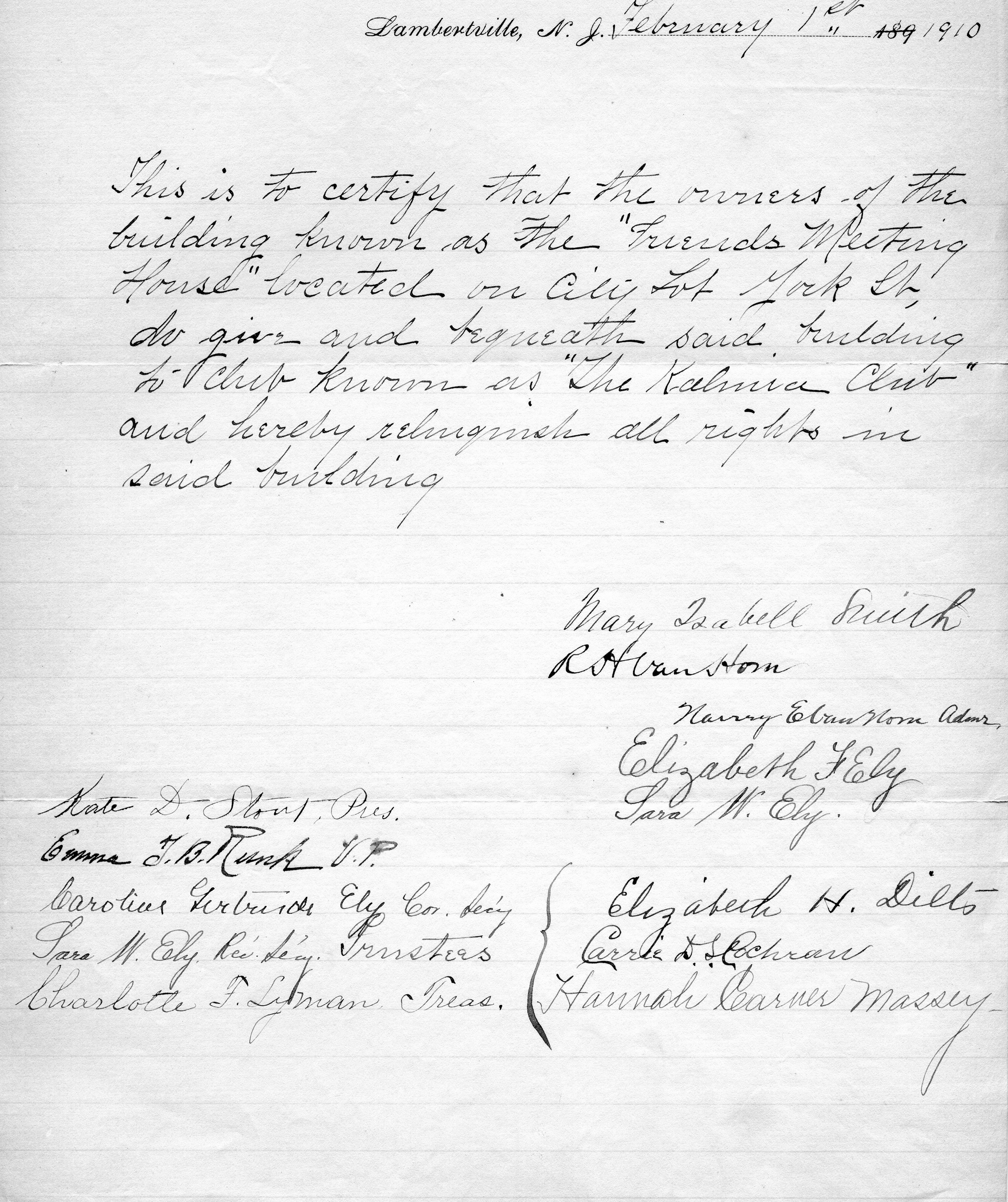
Transfer of Clubhouse Ownership from Society of Friends to The Kalmia Club (Feb 1, 1910)
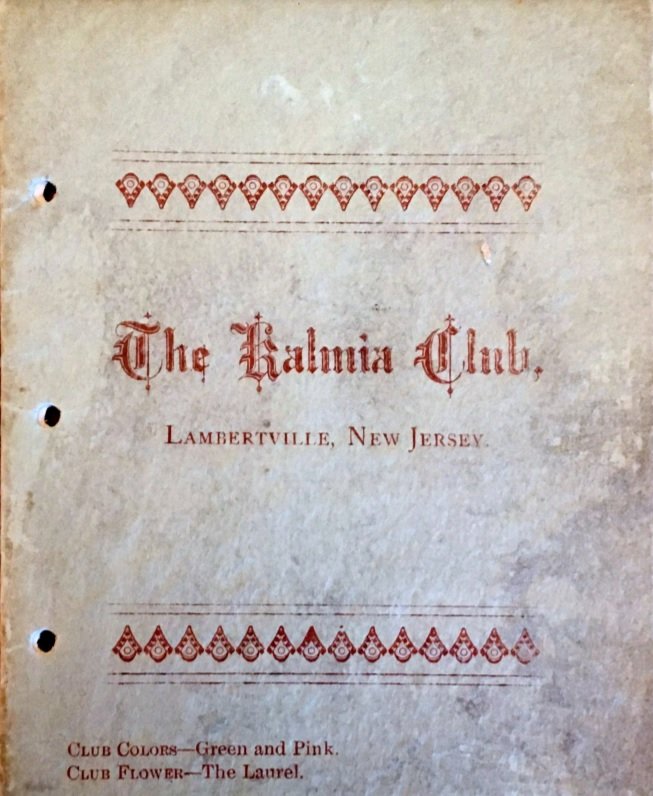
Cover of the first Kalmia Club Yearbook (1898).
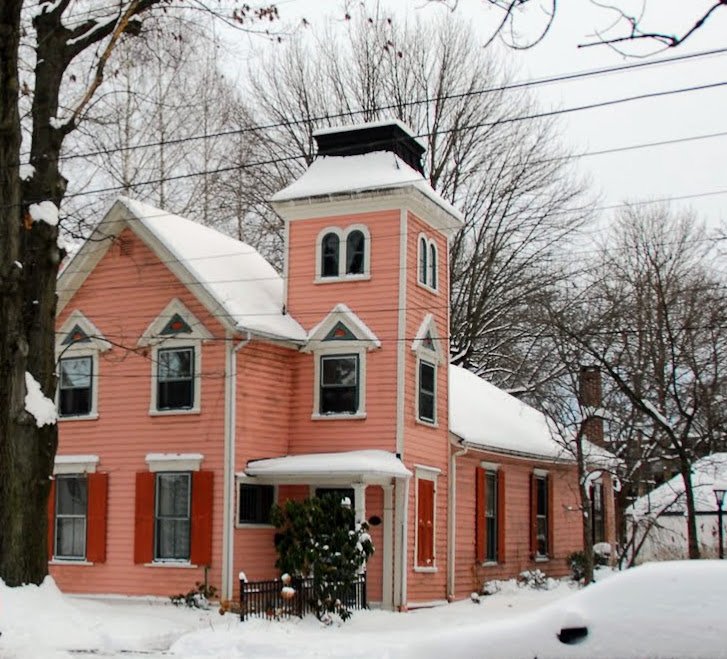
A previous incarnation of the clubhouse. The building was later painted its iconic pink color in 2014.
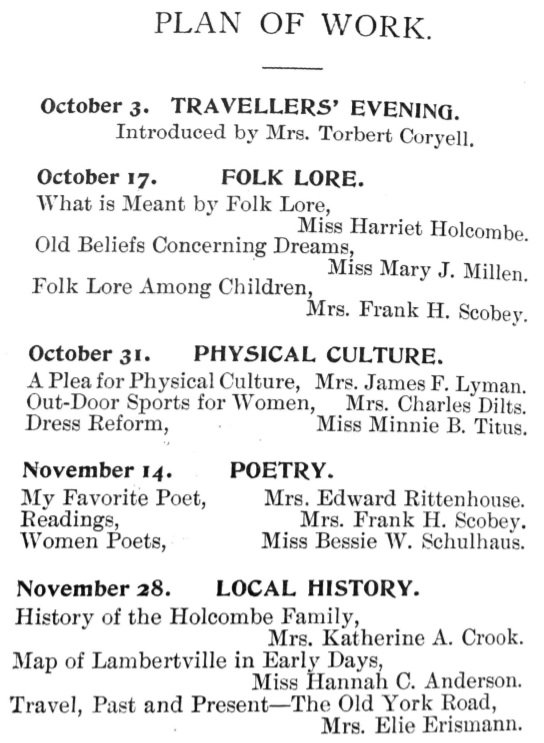
The program from the 1898 Kalmia Yearbook.

Flyer for inaugural Hidden Gardens of Lambertville tour (1996)
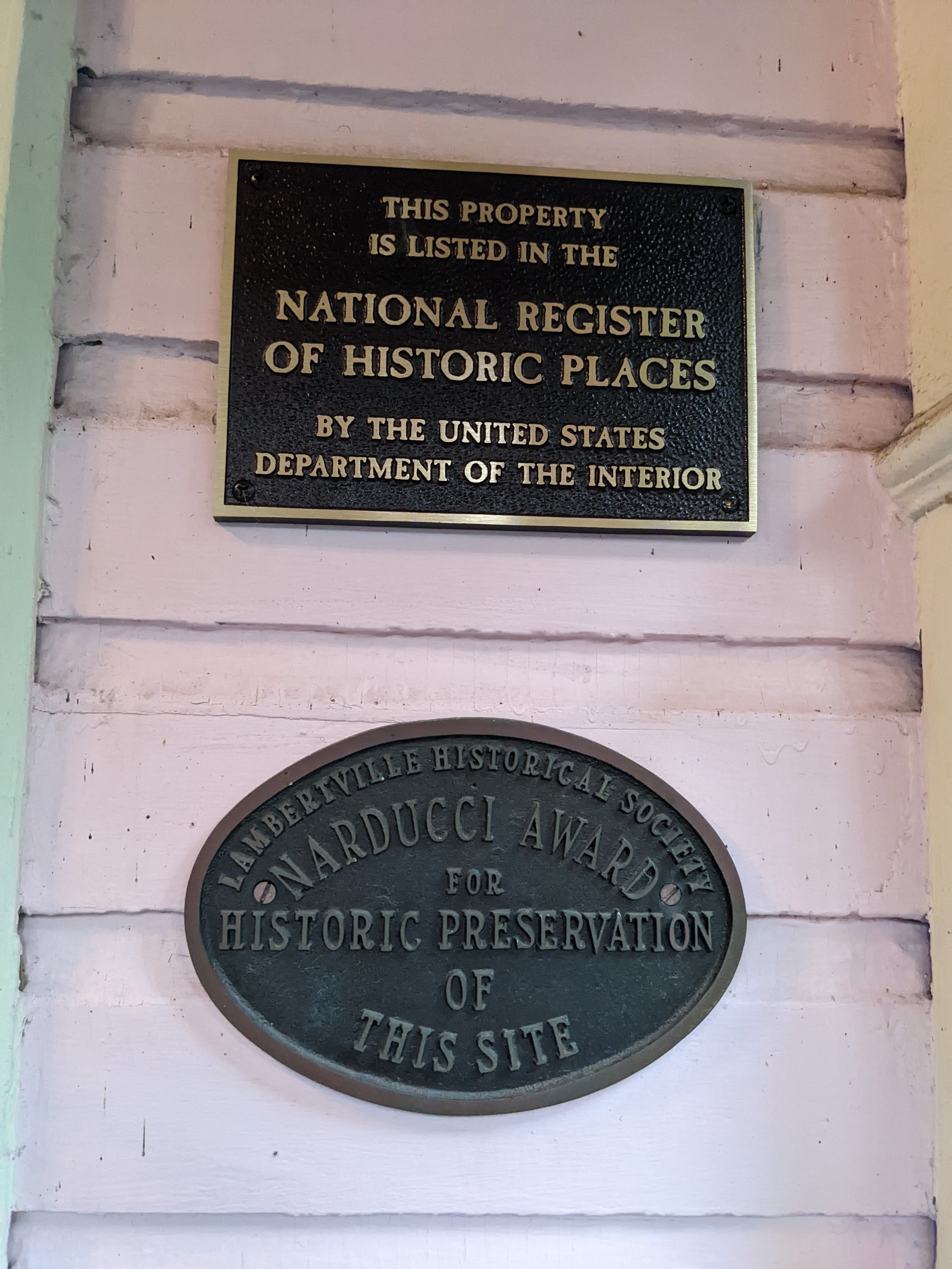
The Kalmia clubhouse was marked with a plaque from the U.S. Department of the Interior recognizing its historical designation in the State and National Register of Historical Places. (June 2022)

Titled "Kalmia Latifolia," this botanical illustration was painted by Anna Anisko, who donated use of the image to the club. It served as the art and logo on the original Kalmia Club website. The website was redesigned in 2024.
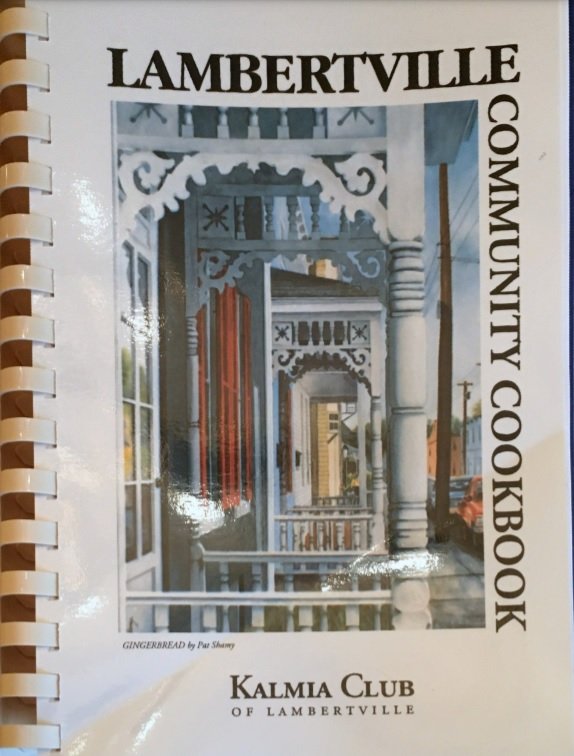
The Lambertville Community Cookbook was a successful fundraising project. (1995)
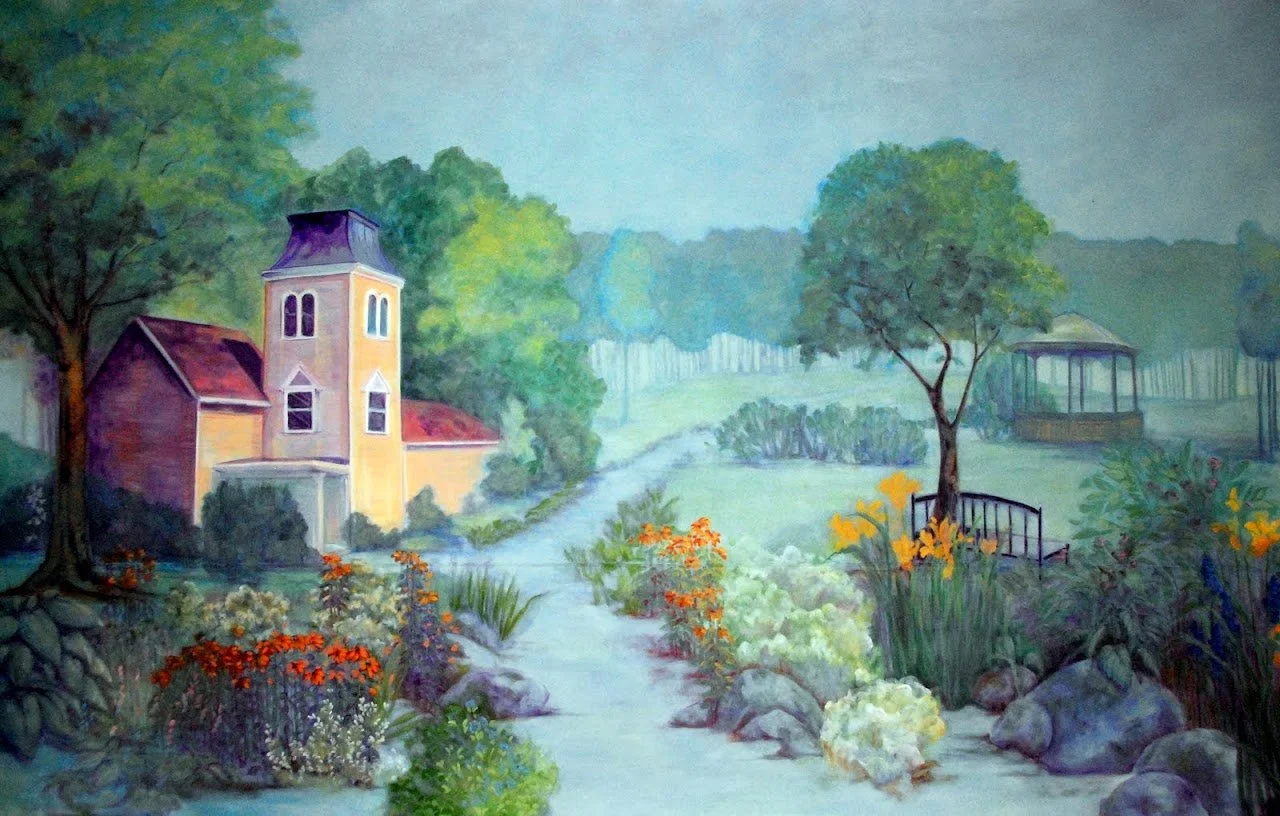
Custom mural commissioned from local artist, Nancy Wodele, for the 100th anniversary celebration of the clubhouse (2010)
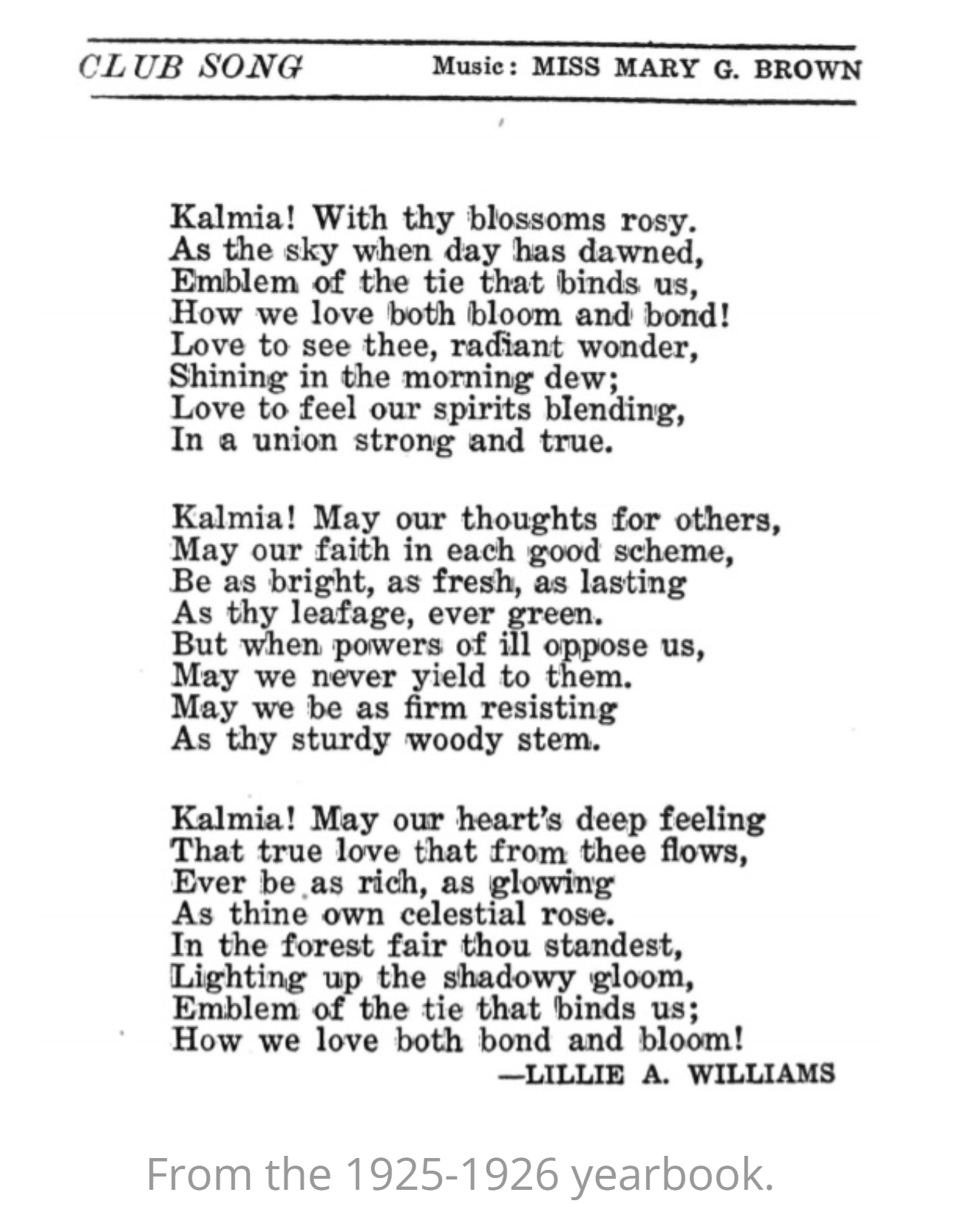
Club Song, from the 1925-26 Yearbook
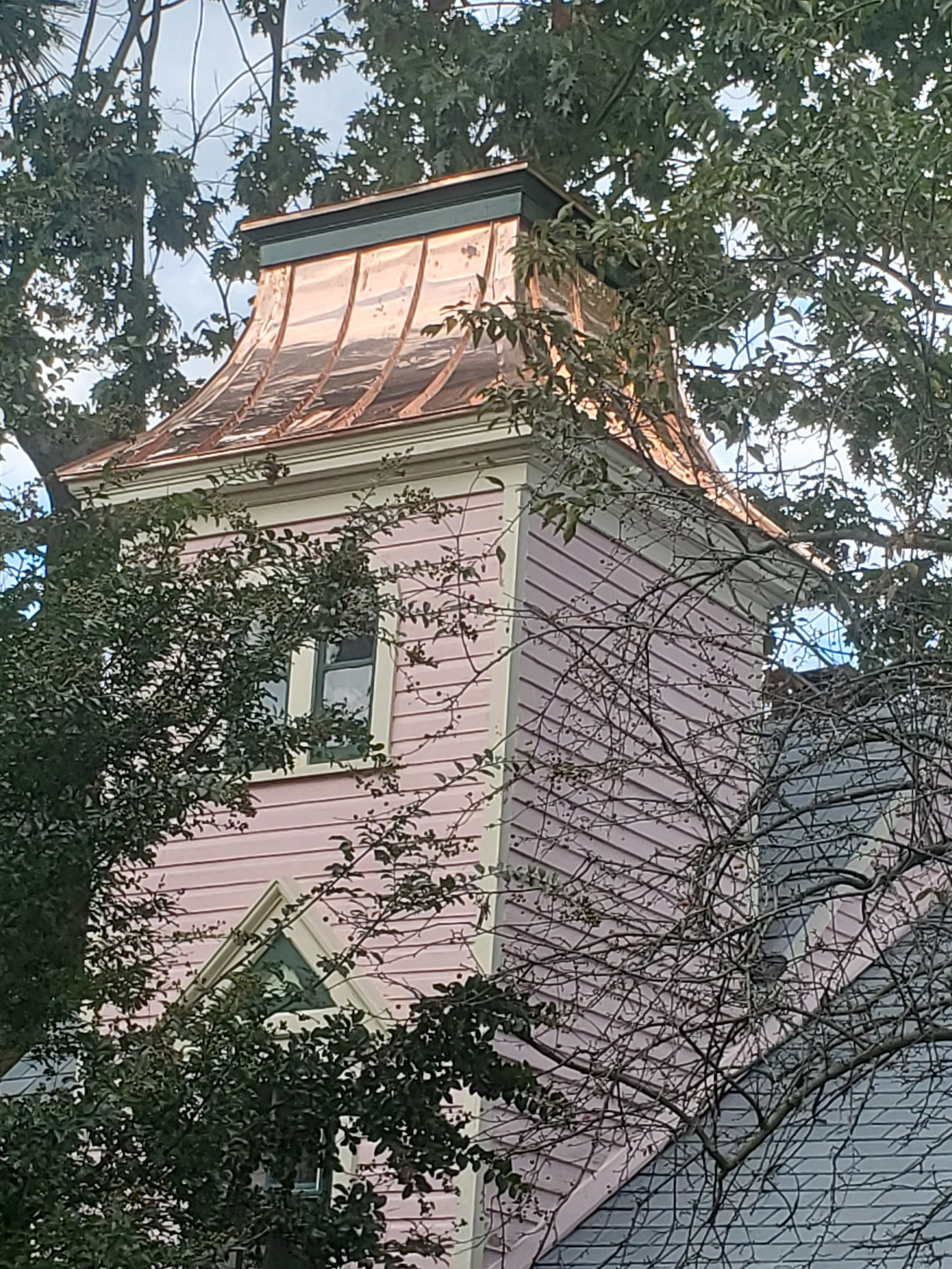
The copper roof on the turret was replaced in 2022. Preserving the historical integrity of the clubhouse is part of Kalmia's mission.
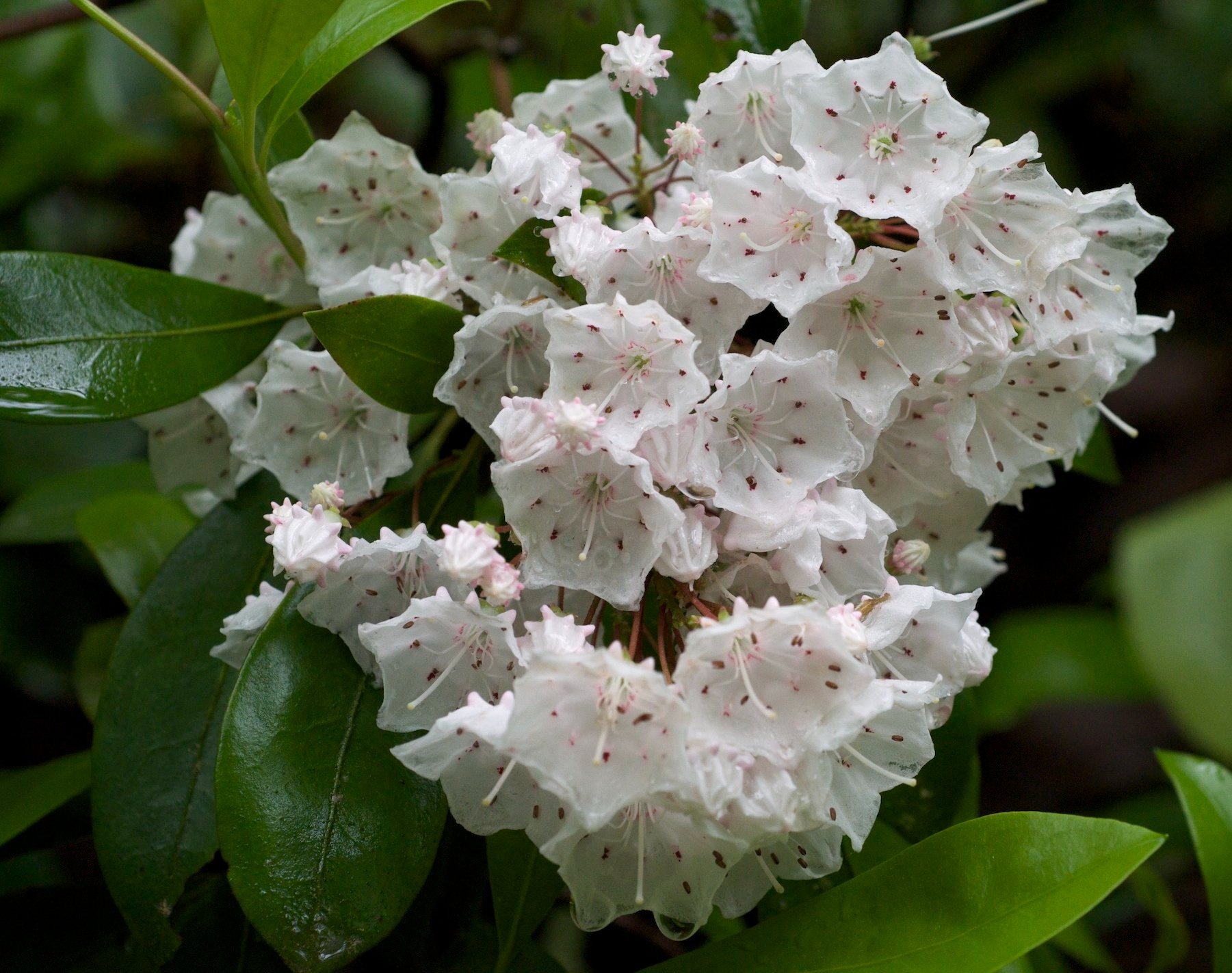
Kalmia latifolia (mountain laurel), for which the club is named.
